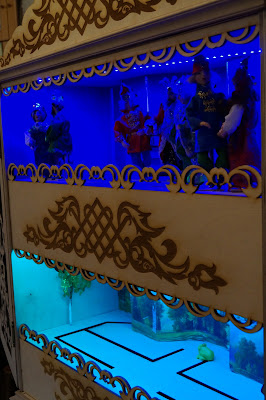The
History of Batleika Art goes back to the early Middle Ages. Batleika theaters
take their origin from static nativity cribs, a Christmas tradition in
cathedrals and churches across the Western Europe. Francis of Assisi set up
a nativity scene as early as 1233. The name "Batleika" has its
roots in the name of our Lord’s native town of Bethlehem. "King
Herod", a play dwelling on the Nativity of Christ is considered to be the
very canonical Batleika show.
First Batleika theatres are believed to have appeared in Europe in the XV-th century. A typical Batleika theatre show would normally consist of two parts - a high-genre performance with religious thematics and low-genre satirical sketches showing scenes from everyday life.
The body frames of Batleika boxes fell into several categories: single and two-storied versions with or without a tower, some had transparent decorations that could be changed several times during a performance, others were equipped with elements for a shadow play show.
Each section of the box layout had its symbolism and served a purpose. The top level in a typical two-storied Batleika, for example, was used for religious scenes only. It had a specially designed place in the centre for the Nativity crib, and the usual cast of characters here would be Jesus, Mary, Joseph and the Three Kings. The left section of the top level traditionally symbolized the Heavenly Kingdom. The lower level with King Herod's throne in the centre was used for scenes from the worldly life. The lower right section of the Batleika box symbolized hell.
The puppets for Batleika shows were made with painted
wood, bright fabrics and natural materials - wool, string, leather,
velvet and brocade. Each puppet had its unique features and
peculiarities. The wooden bodies of the Three Kings, for example, where made
shorter than the fabrics, covering them, because they had to "kneel"
before Christ. Another example would be King Herod's head, that was made
detachable because it had to come off in the end of the show. Music, another
important part of a Batleika theatre, was performed by an ensemble usually
including a violin, a harmonica, a whistle-flute, a tambourine and cymbals.
The ancient tradition that has virtually fallen into
oblivion by the end of the 20-th century, is currently experiencing revival. Contemporary
batleika puppeteers use church-shaped puppet boxes decorated with Angels and
stars and, just like in the old days, their shows usually consist of two parts
– the exalted spiritual one and the amusing secular one.
Sisters of St. Elisabeth Convent became interested in Batleika art three years ago. This is when the Convent hosted the Niabiosy Annual Batleika Festival for the first time. Many troupes from different countries presented their performances, reviving the old tradition and telling people about the Nativity of Christ. The festival is gaining popularity, and today, three years after, it is almost impossible to imagine Christmastide at the Convent without this colourful event.
St. Elisabeth Convent
June 30, 2017






















CONVERSATION